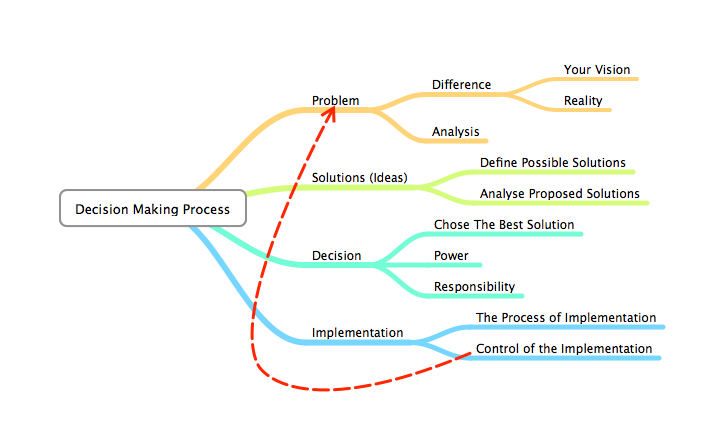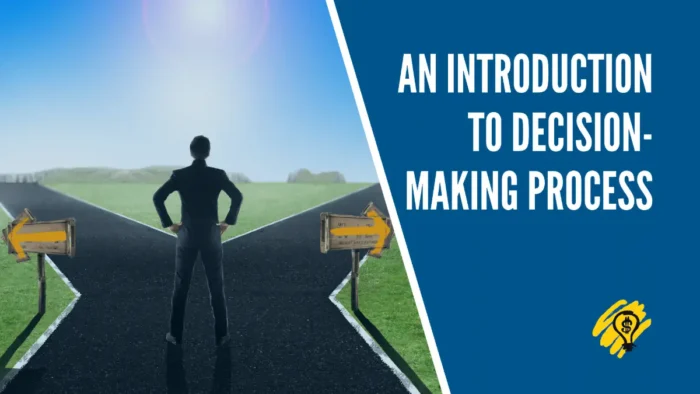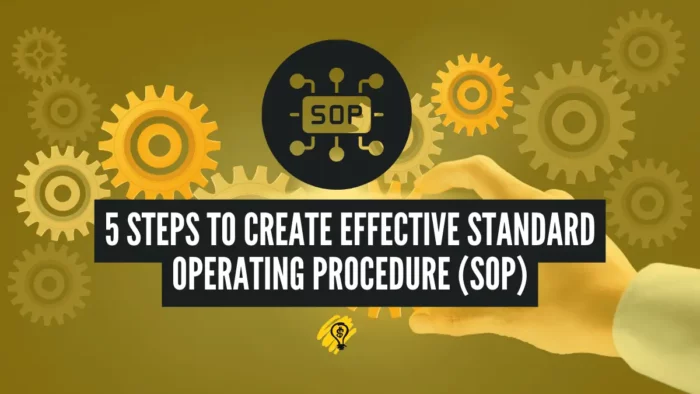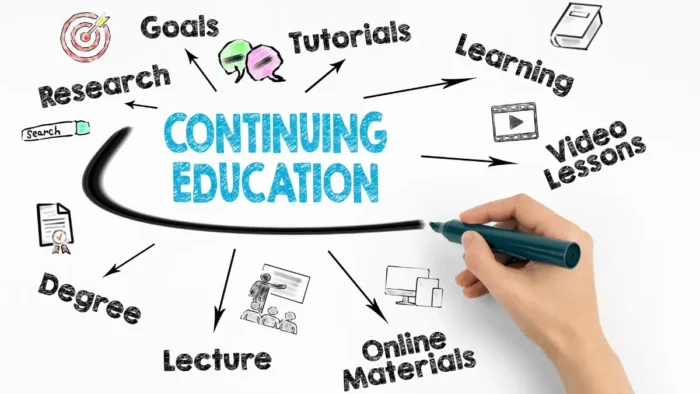We often think about the decision-making process as something simple. Decisions are rarely black and white—they’re nuanced, challenging, and full of uncertainty.
Why do we make some decisions and not others? What makes some choices easier or harder?
The decision-making process is an essential component of the entrepreneurial journey. Without the right mindset, you might fail to make a crucial decision that can make or break your business. As an entrepreneur, you must make different decisions on an everyday basis. You must choose directions and solve problems.
Simply, you will make decisions about everything. To be more successful at making decisions, start by understanding the decision-making process – and why it’s so hard to make good ones.
Introduction to Decision-Making
You are probably in a decision-making situation every day in your personal and professional life, from deciding what to wear for work and what to eat for breakfast to the complex decisions your workplace requires you to make daily. Some people make much more complex decisions than others.
For example, a production plant employee can decide about the diameter of a hole he needs to drill in the processed part. The plant manager will make decisions about the schedule of shifts in the plant, providing the necessary tools and raw materials, the quality of products, etc. The production manager will make decisions related to the operations coordination of different plants, the levels of stock, required resources, etc. The top manager will make decisions about the goals and strategies of the company, vision, mission, and general direction in which the company will move.
As you move through the organizational hierarchy, the complexity of the decisions you need to make will increase.
Related: The Team Effectiveness and Different Roles in Teams That Win
What is the decision-making process?
Decisions are choices, or choices of the many things available to choose from. That thing can be an alternative, direction, solution, or path. So, decision-making is the process of choosing between different alternatives. It may mean choosing new business equipment, expanding in new markets, deciding what marketing tactics to use, or choosing to go solo or take a partner on your entrepreneurial journey.
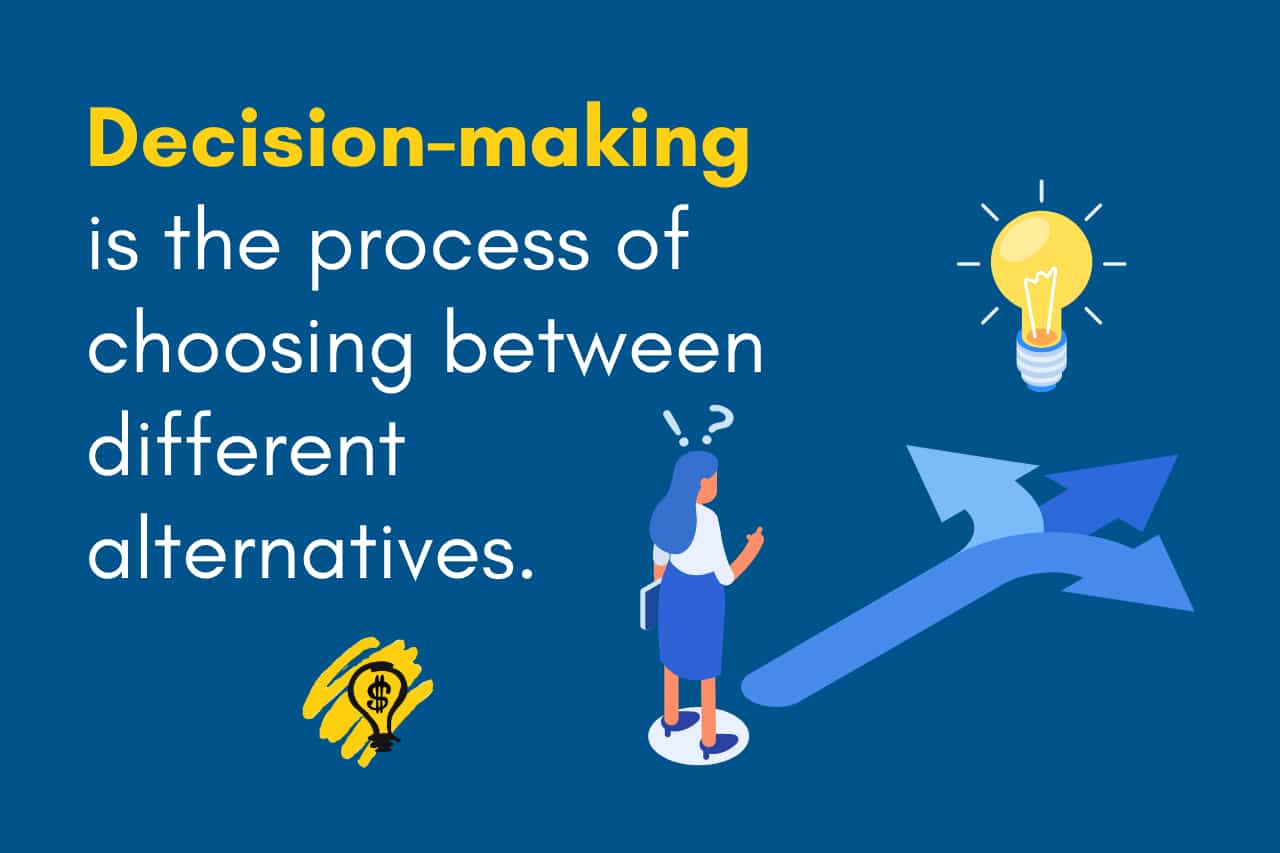
You have several alternatives, and you have to choose one. That is a decision. You have a dilemma about which way to get to the desired destination. Choosing one of several routes is a decision.
If you have more choices, then you have to make a decision. You have several possible solutions to a specific problem from which you have to choose one. Then it is a decision.
Today we can not even imagine having only one alternative. This is normal due to the uncertainty factor where we operate and work daily.
Related: Real-life Organizational Decision-Making Examples
Some elements of the decision-making process
Making a decision will require to be considered many elements. The more elements involved, the more complex the decision-making process becomes.
- Which alternative is better?
- What factors make the alternatives better or worse?
- What does the potential impact of the alternatives mean for me?
- How likely am I to execute the alternative?
- Will the decision result in a net positive or negative outcome for my company?
- What should I do with all of the information?
- How will the decision affect my team members?
What is Problem-Solving
Uncertainty is something that brings more alternatives to choose from and something that makes more directions and paths available to us. The decisions and decision-making are directly related to the problem-solving process, or decision-making is part of the problem-solving process.
According to Ichak Adizes, there is a direct link between change, problems, and solutions. Any change in the current situation in a company, family, or personal life is a source of the problem. So before every problem, there is a change, the basic reason for solving a problem. Problems, however, require a solution, which is a kind of decision.
Change is constant. The world is changing physically, socially, and economically. Even you are changing this very minute. Change creates problems. Problems require solutions. Whenever we decide and implement our decision to solve a problem, we are causing more change. We are the source of change too. The greater the quantity and velocity of the changes, the greater the quantity and complexity of the problems we will have.
Then, Adizes continues:
The purpose of management, leadership, parenting, or governing is exactly that: to manage change. To solve today’s problems that were generated in the past and get ready to deal with future problems we create with our decisions today. No management is needed when there are no problems, and there are no problems only when we are dead. To manage is to be alive, and to be alive means to experience change with the accompanying problems it brings.
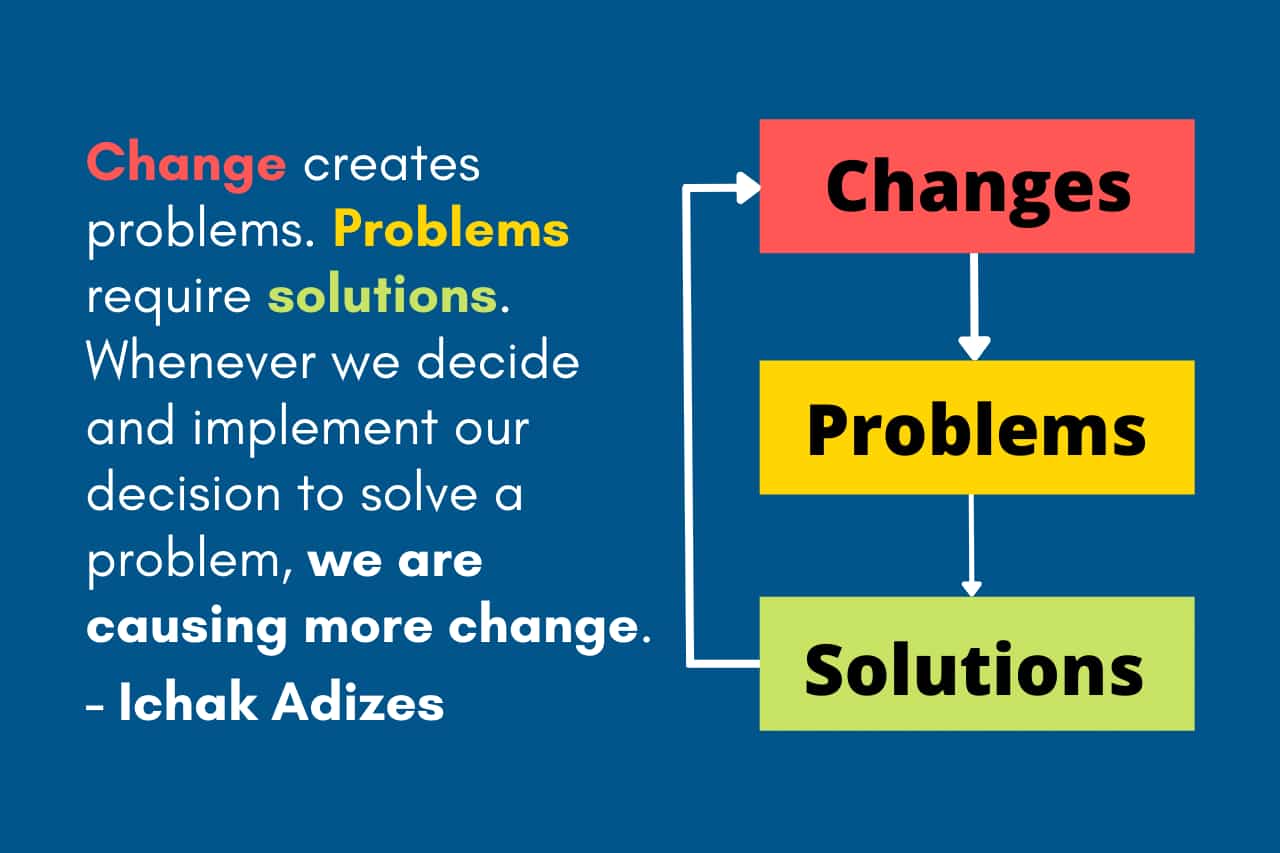
Decision-Making Models
A good decision-making model doesn’t just apply to people. It applies to any situation in which there are multiple options.
How can you decide which solution to use? Most businesses start by creating a plan. But when there are many possible alternatives to choose from, how can you know which ones to implement? Three general decision-making models can help you sort out your choices.
Rational decision-making models
Most people will make decisions based on emotion rather than logic. This is because emotions are much easier to understand and act upon. When making decisions, however, it is important to be logical and make sure you are not missing out on something that could potentially help your team or company.
It’s not always easy to make the right decision. If you are in a situation where you need to decide between two options, it’s hard to avoid bias. However, you can still make the best decision if you take a step back and consider all the different perspectives.
Intuitive decision-making models
Intuitive decisions are decision-making models that use gut instincts. This model requires previous experience and pattern recognition to form strong instincts. Decision-makers with a lot of experience with similar problems often use intuitive models.
Creative decision-making model
The creative decision-making model is a great way to generate solutions to problems. It’s often referred to as the “no-think” approach because instead of actively thinking about how to solve a problem, you let your subconscious mind do it for you. When doing this, you can spend more time developing innovative solutions rather than worrying about whether or not you are doing the right thing.
Creative decision-making is an alternative to the rational decision-making model. It’s a useful tool for entrepreneurs and business leaders who need to make decisions quickly without taking the time to evaluate the best options. It’s also a great way to brainstorm solutions to problems because it helps you relax and focus on your creative process.
How do you make decisions to solve problems?
1. Recognize the problem – the gap
In the first step, you need to recognize the gap between where you are now and where you want to be. At this point, you understand the situation and decide if it’s worth doing something. Is there a better way to do this?
When people don’t know what they’re looking for, they just see a bunch of stuff and assume all of it’s worth looking at. So, when you’re looking for a solution to a problem, start with an understanding of what that problem is. This will allow you better to identify the gaps.
A problem is simply a discrepancy, a gap between the actual state of things and the desired state of things. It is the difference between where you are and where you want to be. You can define your problems as being too low on your sales quota or that you are having trouble getting enough traffic to your website. This is the beginning of a problem-solving process.
In this step, you can start with your vision of the desired state of your company and the goals you want to achieve.
Here are some questions you need to answer as a part of this step in your decision-making process:
- What are the most critical desired states for your small business?
- How close is your small business to these states?
- Why are you close or not close to the desired states?
- What are the most significant problems here?
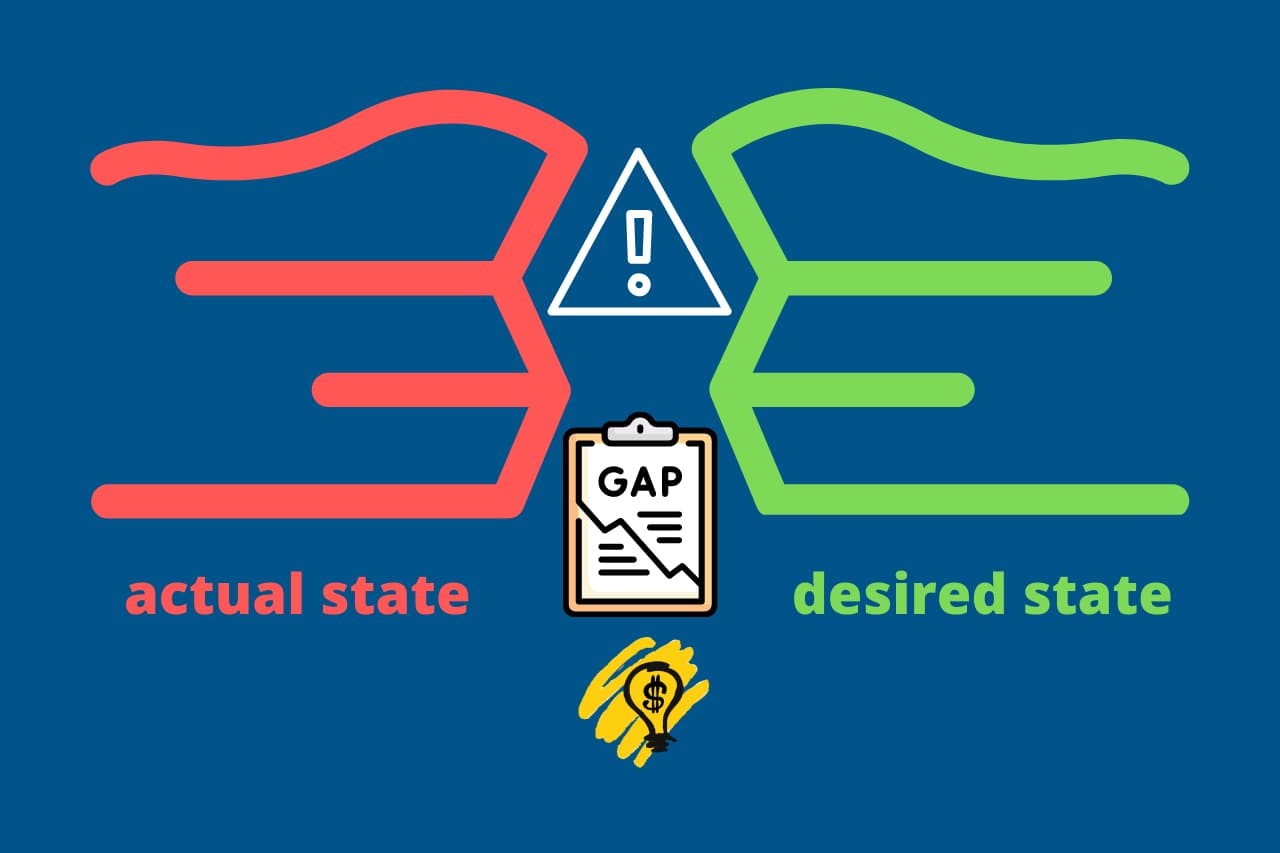
Example: Decrease in income as a problem
For example, if we analyze the company’s income, we can notice that this year’s income is 30% less than the previous year. That is a sign that something is going on and that a potential problem will require a solution.
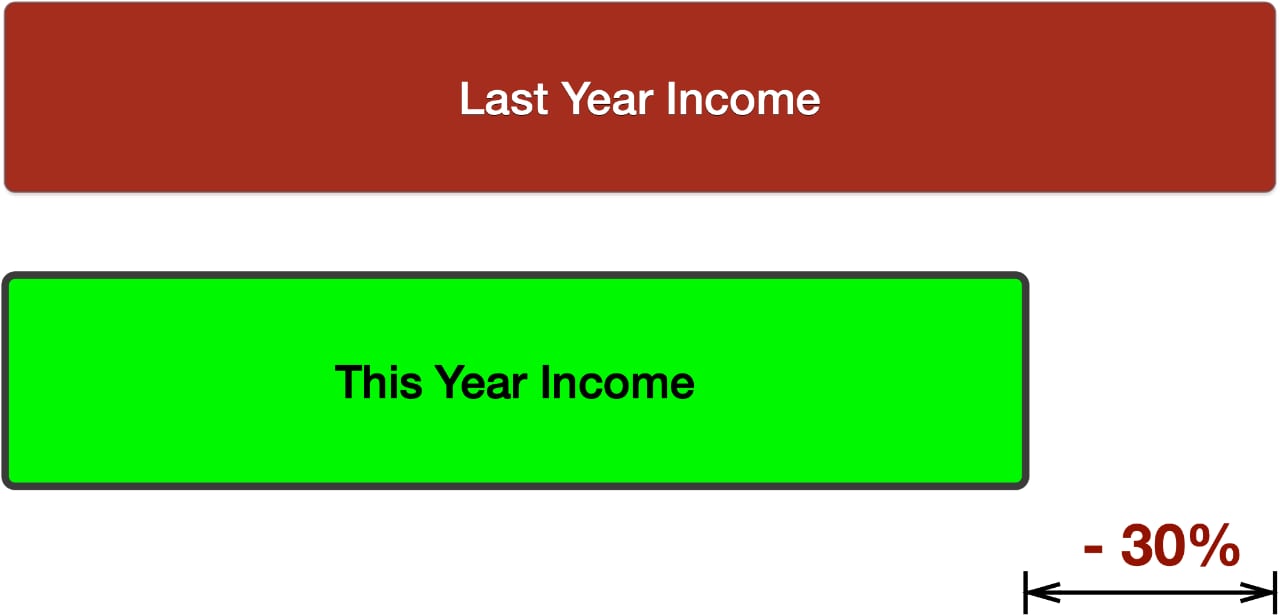
2. Collect All Relevant Information and Analyze the Problem
When you identify the problem, you need to collect all relevant information and analyze it as a part of the decision-making process. Ask yourself, “What is the next step in solving this problem?
Analyzing the problem as part of the decision-making process is about being smart and using data to solve a problem.
People tend to make decisions based on emotions such as anger, fear, or love rather than logic. So, emotions have a lot of influence over our behavior and decision-making. Once we get past the emotion, applying logic to decide the best course of action is easy.
You should always start with data. This is why business schools teach analysis techniques. The analysis allows you to understand the problem at hand in a scientific way and to find solutions that are backed up by real data.
At the end of this step, you will need to have a list of possible problems sorted by their urgency for the solution. Also, you need to find the causes and how the problem impacts your small business in your analysis.
Example: Analyze why there is a decline in income
Let’s go back to our case with a 30% decrease in income. The analysis of the problem at this stage will represent an analysis of sales and marketing activities in the company by regions, employees, used techniques, etc. In this situation, you can find that the decrease in income is due to two regions with a 40-60% drop in income realization. Or the problem occurs only with specific employees in marketing or sales. Or it could be a combination of regions, employees, or marketing and sales techniques. These analyzes aim to prepare you for the next stage of the process.
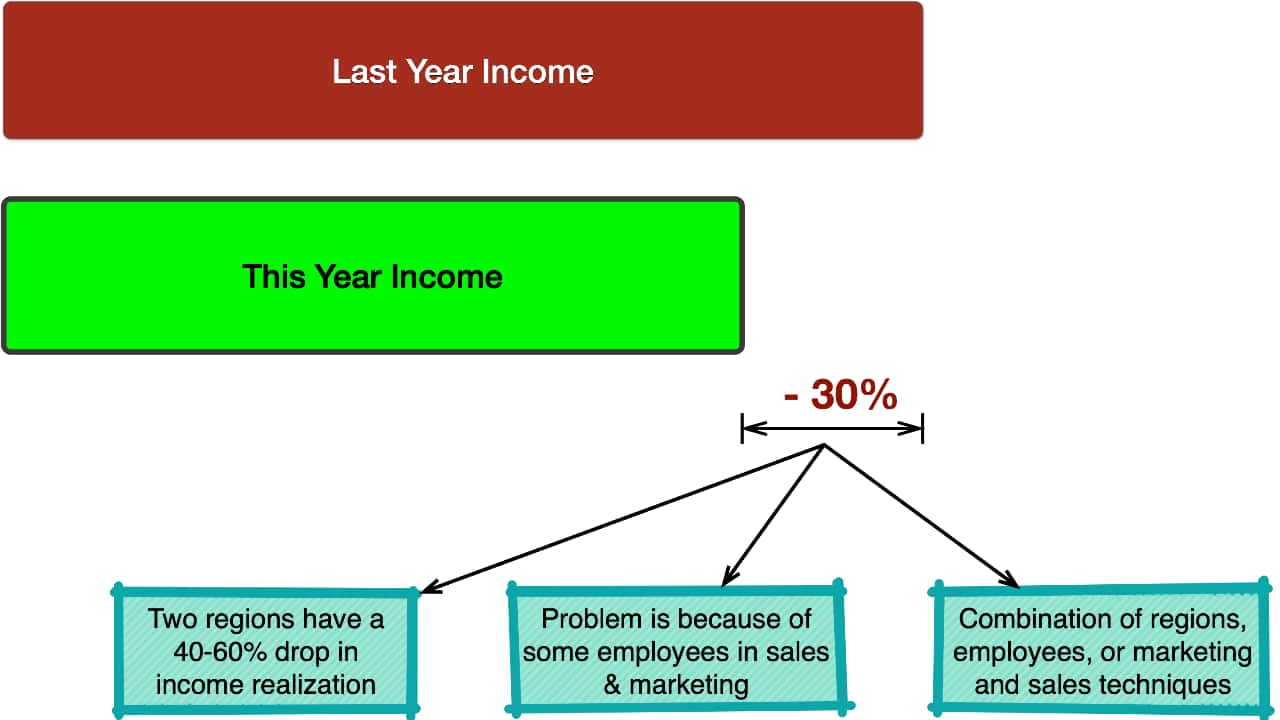
3. Define Alternative Solutions
After defining and analyzing the problem, you can move on to the next phase, which means defining alternative solutions.
Based on the previous analysis’s conclusions, you can easily define alternative solutions to solve the detected and analyzed problem.
You should think about what kind of solutions will solve your problem. When you are thinking about solutions, you should also consider what the consequences would be if you did not have those solutions. Are there better ways to achieve your goal? Would you be happy with your solution? Do you think that the cost is worth it?
The more information you have about your problems, the easier it is to solve them. For example, you can talk to the person causing the problem and ask them to do something else.
Example: Alternative solutions to solve the decrease in income
If the previous step and analysis of the problem tell us that the source of the problem is decreased income in two regions, we can have alternative solutions such as:
- conduct training of the sales and marketing team for those regions
- strengthening marketing activities in those regions, and
- a combination of training and marketing activities.
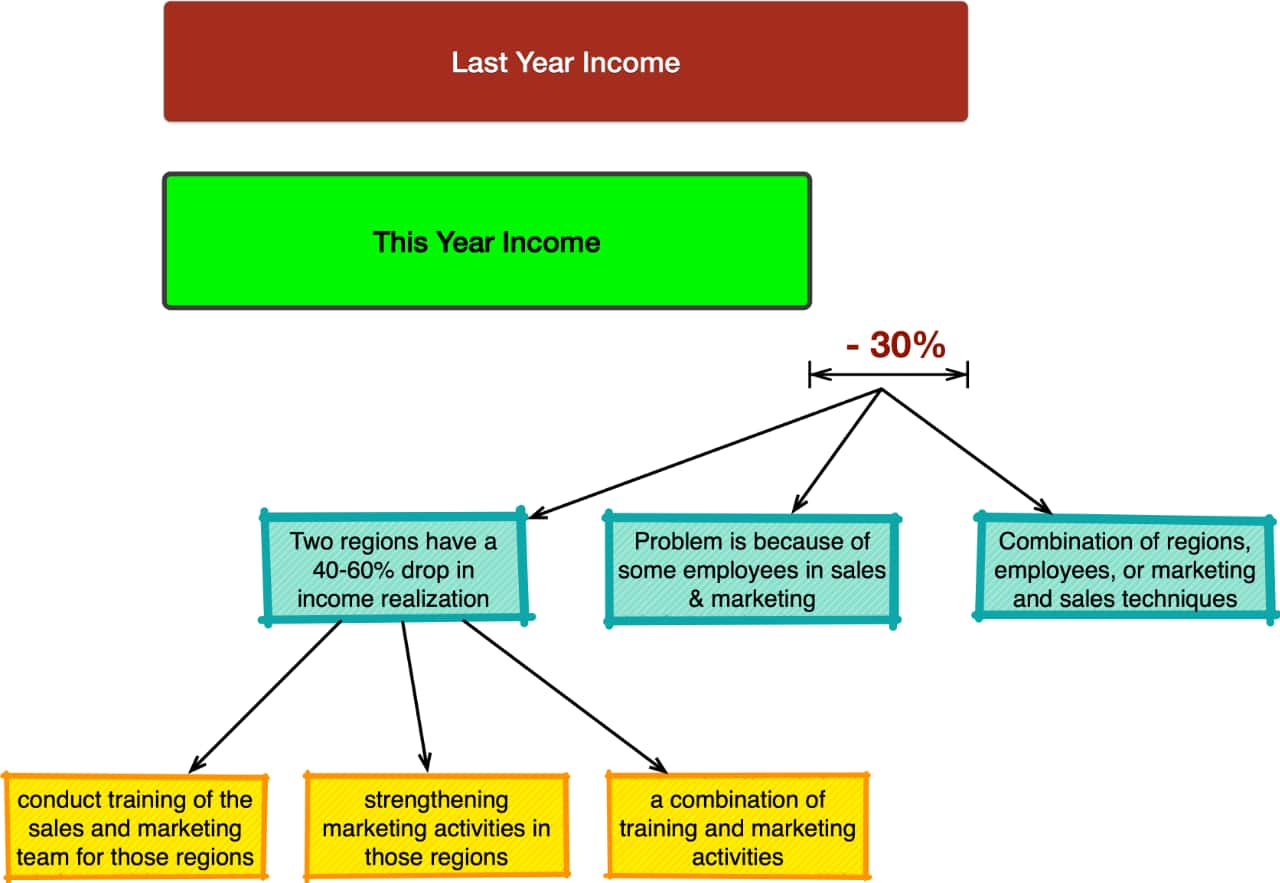
4. Analyze Alternative Solutions
Don’t panic if you have a problem or if there are multiple solutions. You don’t know which one is the best.
Since each solution will bring different outcomes from the problem-solving process, you will need to analyze the solutions to determine the best one for implementation.
Simply, the question that arises is what you will achieve by implementing each of the alternative solutions. In this case, you can use modeling to model the implementation of each solution separately. In such a way, you will find the possible outcomes of all possible alternative solutions and the costs of their implementation.
It’s crucial to analyze all the possible solutions to problems. You should be sure that your ideas and solutions are reasonable and workable. Use logical thinking when analyzing a problem.
The decision matrix and decision tree are the most used tools in decision-making, especially for selecting the best possible alternative solution.
Decision Matrix
When making decisions, you need to consider all the facts. Sometimes, the answer isn’t obvious, and you must choose between two or more options.
A decision matrix can help you decide between two or more options. It’s easy to see the advantages and disadvantages of each alternative solution, as well as how well they fit into the overall picture.
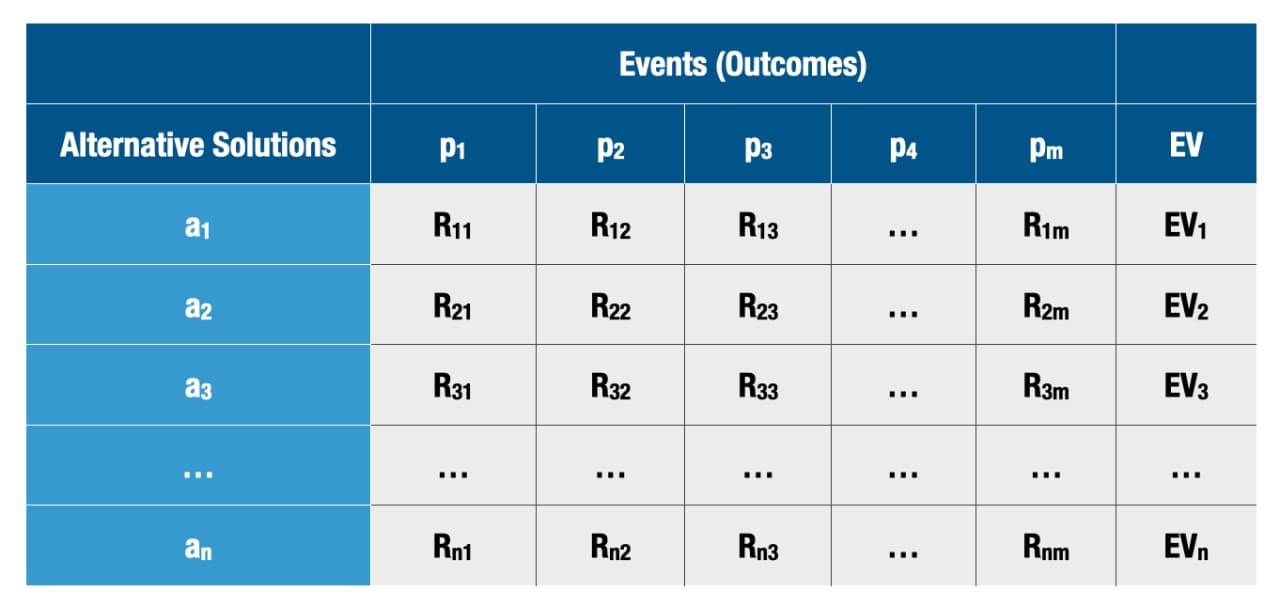
A decision matrix can be developed as a set of vectors that can help you determine the differences between different alternative solutions in terms of the result of their implementation.
The decision matrix contains the following:
- Alternatives available to the decision-maker ai where i = 1, 2, 3, … n.
- Events that may occur and the occurrence of which will affect the outcome of each particular alternative. Each event has a probability of occurrence pj where j = 1, 2, 3, … m.
- The outputs as the results of a combination of each alternative with each Rim event.
- The payoff is a measure of the consequence like profit, income, or other expected value.
Using this matrix, for each combination of an alternative and possible event, you will know what will be the resulting payoff.
Simply, each alternative has different outcomes. The most used approach in such cases of solving decision-making problems is called expected value – EV. Using the EV for each outcome about an alternative and a specific event defines the probability of occurrence of that specific event. So, the EV will be the total value of the results in any given row (alternative) in the decision matrix with the probability of each event. In such a way, we calculate the EV for each alternative solution and choose the alternative with the highest EV.
The biggest problem in such decision-making problems is to define the probabilities of the specific events that may occur. How can you find the appropriate probabilities for events that may occur when choosing one of the alternatives? The answer to this question will depend on the specific problem you need to solve. Here is what you can do:
- The first is using historical data based on mathematical models to calculate the probabilities of the event.
- Use of experiential methods by decision-makers, whereby the probability of the corresponding event will be defined based on your experience. For example, if an event in the past happened in 40% of cases, then the probability will be 0.4).
- Using intuition is not recommended in such situations when we know that we can use scientifically proven mathematical models to determine probability.
Decision Matrix – Example
For example, you want to invest in developing a new product. If competition with the same product appears, the profit from that new product for the company will be $1.000.000 per year. If there is no competition, the profit will be $3.000.000 annually. The probability of the event that you will be without competition in the first year is 0.3, i.e., 30%.
Should you invest in the development of that new product or not?
In this case, we have the following two alternatives:
- to invest in the development of a new product
- not investing in the development of a new product
We also have two events with their probability of occurrence:
- there will be competition with a probability of 0.3
- there will not be competition with a probability of 0.7.
But we also have payoffs for the company that is affected by the corresponding event:
- if there is competition, the profit will be $1.000.000.
- if there is no competition, the profit will be $3.000.000.
Based on this data, we can construct a decision matrix:
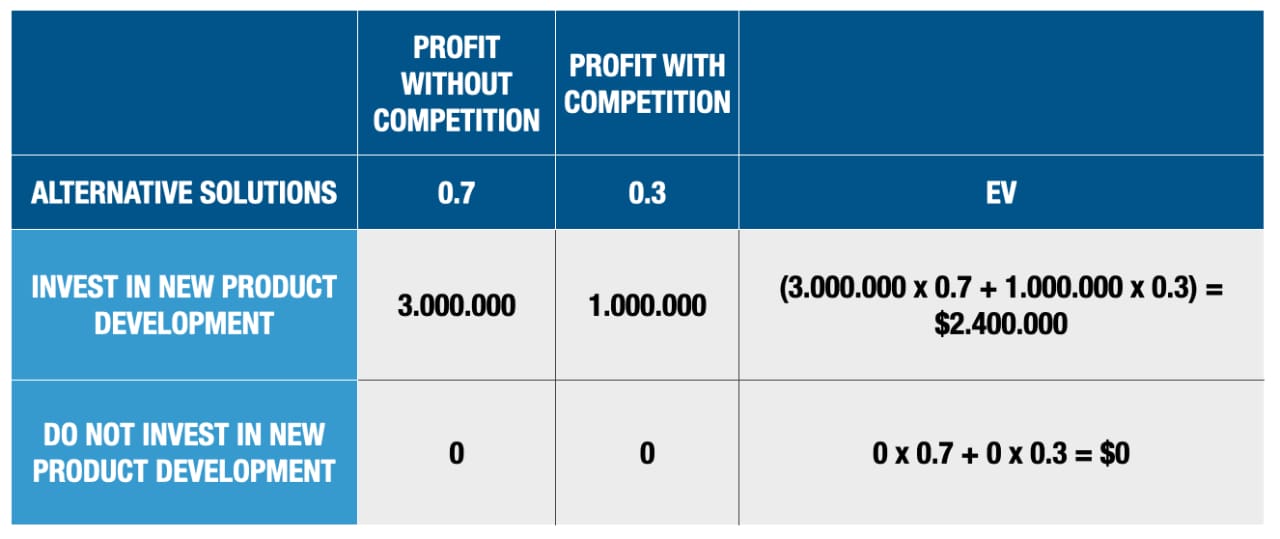
In this case, the first alternative, to invest in new product development, is a better solution.
Decision Tree
Even though some decisions can be analyzed and made effectively using a decision matrix, we can also illustrate alternatives (possible actions) and events in a visual form known as a decision tree.
For example, if you want to invest in developing a new product, there are three types of products available. From the first product, you can earn $1.000.000, from the second $2.000.000 and from the third $1.500.000 with competition in the first year. Without competition, from the first product, you can earn $3.000.000, from the second $4.000.000 and from the third product $3.500.000. It is known that the probability of having competition for the first product is 0.3, for the second 0.4, and for the third 0, and the probability that there will not be competition for the first product is 0.7, for the second 0.6, and for the third 1.
Here is the decision matrix for this example.
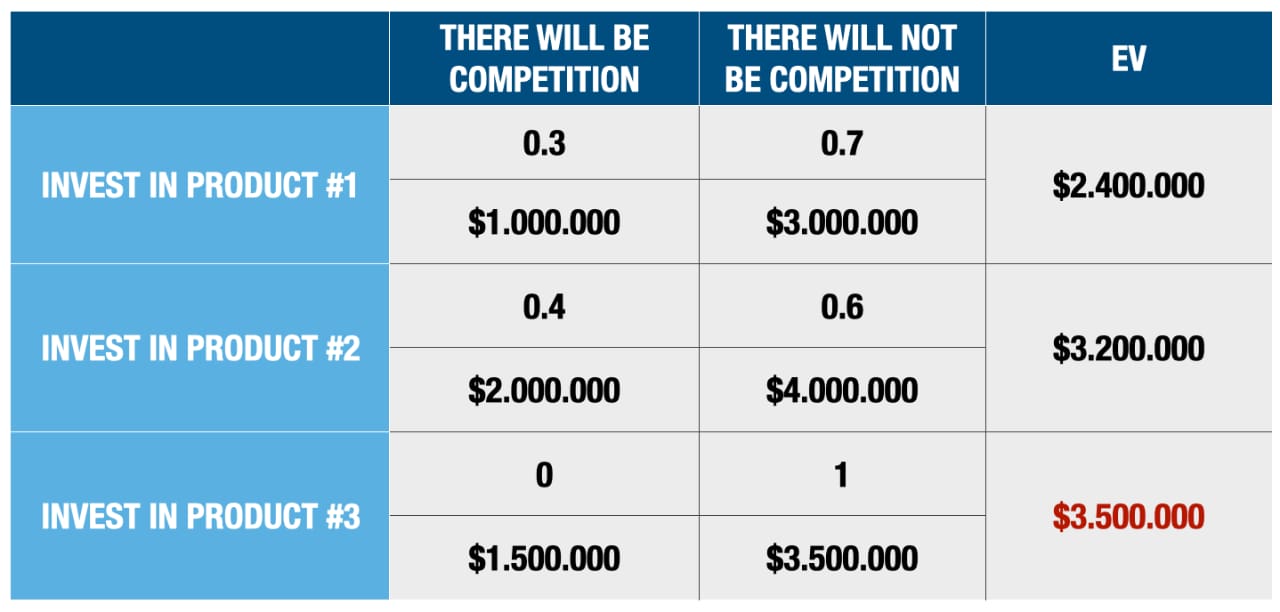
In this case, we will have at the beginning a decision on which product to invest, product 1, 2, or 3. Each of those possible decisions branches out further, setting the possible events and the probability that those events will happen.
- There will be competition with a probability of 30% (0.3)
- There will not be competition with a probability of 70%.
Each of those events brings a corresponding benefit or loss to the company. So, for the decision for the first product to have competition, the profit will be $1.000.000, while in the absence of competition, the profit will be $3.000.000. In the same way, we can continue with the second and third products.
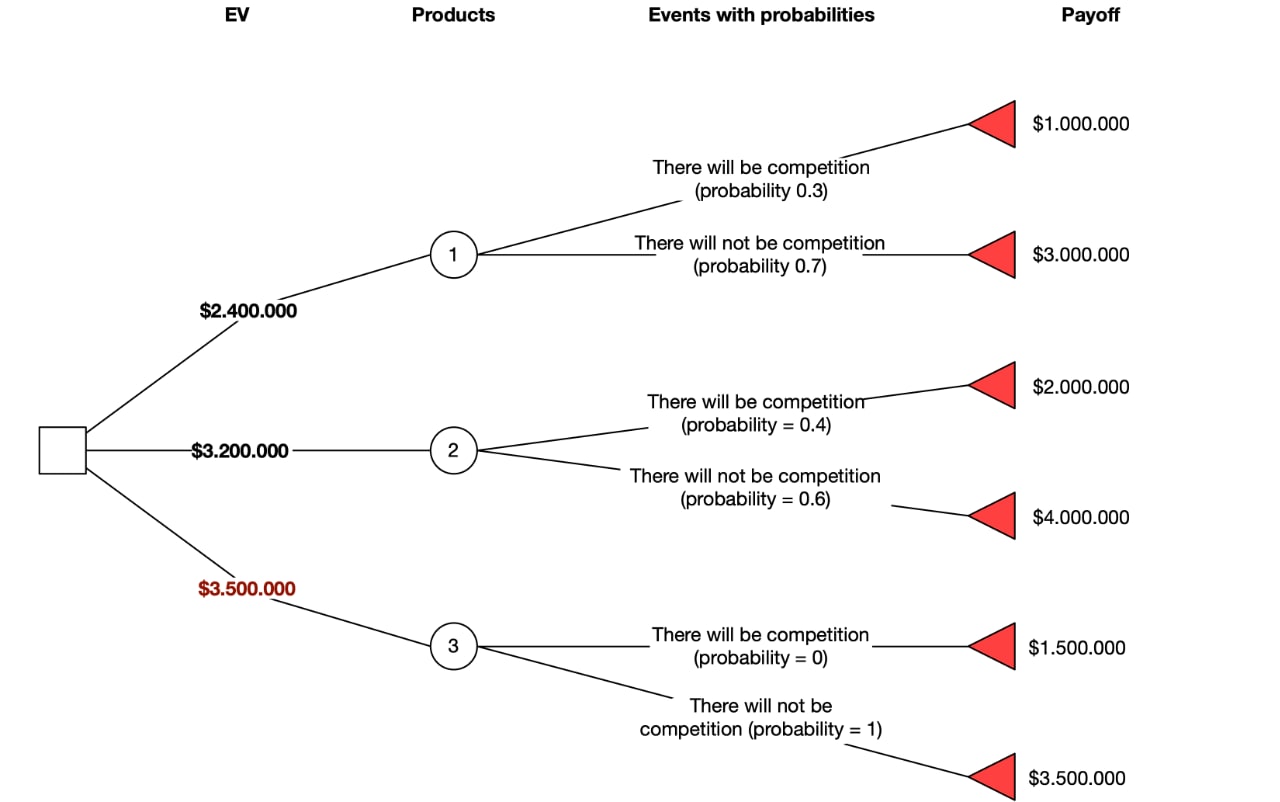
5. Choose the Best Solution
The next step is to choose the best solution to your problem. Choose the one that will solve your problem best. Don’t be hasty with your decisions.
When you analyze the alternative solutions, you can rank them according to specific criteria that will provide the best conditions and results for the company. Selecting the alternative solution will almost always require an optimal solution. An optimal solution is the one that will give you the best results with the least effort and costs for the company. Simply, the results of the previous stage enable the ranking of the alternative solutions, with which the best solution, i.e., optimal, will be chosen.
6. Implement the decision
A critical aspect of the decision-making process is the implementation stage. After you have decided what to do, you need to do it. Don’t procrastinate. Don’t put off doing the job. Get it done, and then move on to another task.
But why do you need a decision if you don’t implement it? Every decision is made to be implemented. Implementing the decision will also mean solving the problem, i. e. , improving your small business.
Once you have decided, you must move forward and execute it. You can’t just talk about making decisions. You must also act on them.
7. Review and Feedback
Understanding that this review is not a rehash of the original decision is essential. Instead, it is a summary of the decision and a chance to reflect on it. Doing so lets you see if you made the right decision in the first place.
I suggest you review your decision after a predetermined amount of time. When you feel that you are in a better place than before, you can look back and see what worked and what didn’t. This is an excellent time to reflect and evaluate. Take note of what worked and what didn’t. This will help you formulate a new plan of action. It’s never too late to make a change, but it is better to be proactive rather than reactive.
There is no such thing as perfect. You are trying to get better and learn from your mistakes. If you don’t make mistakes, you probably are not doing anything! So, learn from your mistakes, don’t try to hide them, and try to do better next time.
Frequently Asked Questions
Decision-making is part of the problem-solving process where you must choose between alternatives.
Three general decision-making models can help you make decisions: rational, intuitive, and creative.
The first step is to recognize the gap between where you are now and where you want to be. Then you will need to collect all relevant information and analyze the problem. The third step is to define alternative solutions for the specific problem you have analyzed. The next steps of the problem-solving process are related to the decision-making process.
The first step is to analyze alternative solutions. There are many tools, but the decision matrix and decision tree are the most used for analyzing and ranking alternatives. The second step is to select the best possible or optimal solution. Next, you will need to implement the selected solution. The last step here is to check if everything is OK or you will need to make some changes to the solutions you have chosen.
Conclusion
A decision-maker is a person who can think about a problem and take several different options and weigh their pros and cons. The faster you can make the right decision in a competitive environment, the better. Your ability to quickly make decisions will make or break your business. That’s why mastering the art of decision-making will make you a better leader, employee, and business owner.
So what does the decision-making process entail? Simply, you must define your question clearly, then gather and analyze the information.
Even though it may seem like a simple process, it’s incredibly complex because every decision comes with a set of variables and constraints, each of which affects the outcome differently. It’s essential to understand all possible outcomes because if you only consider a few possibilities, you will be unable to take advantage of any opportunities you might otherwise miss.
The decision-making process is often regarded as a collection of rules, procedures, and practices followed by individuals or groups when making a decision. The outcome of decision-making depends on various parameters such as the complexity of the decision, the stakes involved, the level of uncertainty, etc.
As you can see the overall process described above can be divided into the following four parts (see picture below.)
